
|
Sale 80
June Pre Long Beach Sale
| Lot |
Photo |
Description |
Realized |
Lot 1 |
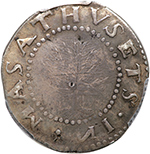 |
1652 Massachusetts Oak Tree Shilling Noe-10 Rarity-6+ PCGS "Genuine" VF Details, Damage. Attractive glossy light to medium gray. The surfaces are smooth and the designs are nicely centered on the planchet. The only significant mark is a thin vertical scratch in the field left of the date and denomination, and this scratch has been lightly smoothed to minimize its appearance. The Oak Tree was delicately carved into the die resulting in the "Ghost Tree" label applied to the variety, but the other designs and legends on both sides are strong. A decent example of this very rare variety. Listed on page 39 in the "Redbook." The "Ghost Oak Tree" type and weight of 67.28 grains are shown on the PCGS label.
Estimated Value $1,000-UP.
View details and enlarged photos
| Realized
$3,290 |
Lot 2 |
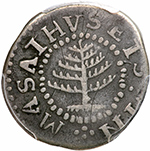 |
1652 Pine Tree Shilling. Small planchet. PCGS graded VF-25. Glossy medium gray with light silvery gray toning on the devices. Excellent eye appeal. The only mark is a thin scratch down through the lower right branch of the tree. Struck slightly off center to K-4 leaving a few letters of the legend partially off the planchet, but the Pine Tree, date, and denomination are all bold. Late die state. An attractive mid-grade example of this famous early colonial issue. Listed on page 39 in the "Redbook." Weight listed as 66.4 grains on the PCGS label (PCGS # 24) .
Estimated Value $2,500-UP.
View details and enlarged photos
Check results on similar lots
| Realized
$2,585 |
Lot 3 |
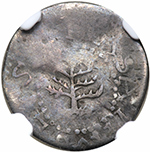 |
1652 Massachusetts Pine Tree Threepence Noe-36 Rarity-4 NCS graded VG Details, Plugged. Glossy light grayish steel and medium gray. Most of the designs are consistent with a grade of Fine or better, but the planchet is uneven causing many of the designs on the tree side to be worn smooth. The date, denomination, all of NEW ENGLAND, and most of the Pine Tree are clear. The only significant defect is a tiny and barely visible plug through the top of the first S in MASATHVSETS. This variety does not have pellets on either side of the tree trunk, and this feature is indicated on the NCS label along with the weight (15.8 grains). Listed on page 39 in the "Redbook."
Estimated Value $500-UP.
View details and enlarged photos
| Realized
$940 |
Lot 4 |
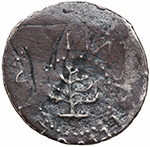 |
1652 Massachusetts Pine Tree Threepence Noe-36 Rarity-4 VG-7. The sharpness is considerably better where the designs were properly impressed, but this piece has been burnished to minimize roughness. The roughness most likely is a result of having been lost in soil or some other unfriendly environment for many years. Both sides show myriad fine hairline scratches left behind by the burnishing, and traces of corrosion can be found on both sides. The protected areas are dark steel gray mixed with some chocolate tones while the highpoints are a lighter shade of silvery gray. The date, denomination, and Pine Tree are clear as is most of NEW ENGLAND. The obverse (tree side) was badly misaligned to K-6 while the reverse was nicely positioned on the planchet. Far from perfect but the critical elements are strong. Weight 16.7 grains. Listed on page 39 in the "Redbook."
Estimated Value $500-UP.
View details and enlarged photos
| Realized
$852 |
Lot 5 |
 |
1723 Rosa Americana Twopence with Crowned Rose Breen-92. PCGS graded AU-55. Glossy steel brown and light chocolate with traces of golden tan in protected areas on both sides. The only defect is a faint hairline scratch from the rim at K-2 to the nose and cheek, but this mark is barely visible. The 3 in the date appears to be over a 2, but there is a bit of dirt in the way of a clear view. Variety with a stop after the X in REX but none following the date. Listed on page 43 in the "Redbook."
Estimated Value $600-UP.
View details and enlarged photos
| Realized
$911 |
Lot 6 |
|
Trio of Colonial Coppers. Includes 1723 Woods Hibernia Halfpenny VF20 sharpness net VG7 for corrosion, 1760 Voce Populi Nelson-10 Rarity-5 G6, and 1788 Massachusetts Cent Counterfeit/Copy VF30. Lot of 3 coins.
Estimated Value $100-UP.
View details
| Realized
$129 |
Lot 7 |
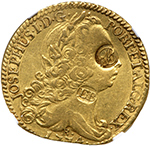 |
1774-R Brazil Rio Mint Gold 6400 Reis Regulated by Brasher & Burger. NGC graded EF-45. Very attractive bright yellow gold with generous traces of frosty mint luster remaining in the protected areas. The only "defect" is the obvious filing on the edge at the bottom of the obverse where the weight was adjusted to its present 13.972 grams. The required adjustments to regulate these coins could be in the form of a plug added to the coin or filing/clipping on the edge to remove metal. The adjustment to this coin required the removal of metal, and this was accomplished by filing on the edge at the bottom of the obverse. As a result the lower half of the date is gone but enough remains to easily read it. This piece received two stamps intended to certify it's weight and fineness. The larger and more strongly impressed of the two is an oval on the eye of King Joseph I (Josephus I of Portugal as Brazil was a Portuguese colony until 1822, and the king's name led these to be commonly called a "Joe" or "Half Joe"). That incuse oval contains a raised "JB" in ornate script. This stamp is for New York goldsmith John Burger, a well-respected coin regulator who worked out of an office at 207 Queen Street in New York City. His stamp almost certainly was the first of the two stamps since he regulated gold in New York from approximately 1784 to 1790. The smaller stamp is positioned on the throat. It is an incuse oval with raised "EB" for Ephraim Brasher (1744-1810), the famous goldsmith and silversmith from New York. He was a neighbor and friend of George Washington and was commissioned in 1792 by the federal government through Alexander Hamilton, Secretary of the Treasury, to perform assay services for the government and to "regulate" foreign gold and silver coins for use in American commerce (the US Mint did not strike silver coins until 1794 and gold coins until 1795). Records indicate Brasher did not get paid for this service until 1796, and the amount he received was $27. This coin was adjusted and certified by Brasher to a value of $8 (by the standards of New York at that time). Very few regulated gold coins have survived the melting pot, and this is an attractive example with two significant stamps. While it may not be as valuable as the famous Brasher doubloons, it is extremely rare and historically significant. See page 63 in the "Redbook." The weight, regulated value of $8, and both counterstamps are noted on the NGC label.
Estimated Value $40,000-UP.
View details and enlarged photos
| Realized
$58,750 |
Lot 8 |
 |
1776 Continental Dollar in Pewter Newman 3-D Rarity-3. PCGS graded MS-64 PQ. The "CURRENCY, EG FECIT" type. Choice frosty light silvery gray with satiny mint luster in the fields and protected areas. Sharply struck and nearly flawless offering exceptional eye appeal for the grade, very close to gem. This example is nearly void of the "tin pest" spots that normally are found on pewter examples, the only spots being confined to barely visible places on the rim. A speck of pest on the rim over the Y in CURRENCY is a good identifying mark for this piece. Struck from a relatively early state of the dies. The die crack that extends through many of the links on the reverse is light. This is a sharp, beautiful example of perhaps the most historically significant coin ever struck for the United States. It was the first coin authorized by the newly formed Continental Congress in 1776, and the examples struck in silver are rightly considered to be the first real "dollar" coin struck for America. Listed on page 85 in the "Redbook."
The design motifs on both sides are based on sketches by Benjamin Franklin, first used on the paper Continental Currency emission of February 17, 1776 and later also on the Fugio Cents of 1787. A radiant sunface illuminates a sundial at center, with the legend FUGIO (translated as ''I Fly'', referring to the flight of time) between two solid circles, and the legend MIND YOUR BUSINESS below sundial, goading the viewer to not waste time in one's daily affairs. The legend CONTINENTAL CURRENCY 1776 is at outer obverse circumference. The reverse is composed of motifs and legends that also radiate from the center. At dead center is the legend WE ARE ONE, surrounded by a circle, followed by AMERICAN CONGRESS surrounded by a radiate circle. Around the entire circumference are linked rings inscribed with the 13 colonies' names in full or in abbreviation. A "PQ" example in every respect. Truly an impressive coin, and an important piece of numismatic heritage that will surely elicit strong bids at auction. Pop 12; 4 finer, 3 in 65, 1 in 66.
Historic background: The Continental Currency unit is, as noted above, the first large, dollar-size coin proposed for the United States. A private issue, whose types derive in due course from designs made famous by Benjamin Franklin, its place of minting and ultimate coinage purpose remain obscure. Silver specimens, which are very rare, appear to have been struck to a close approximation of the value of a Spanish milled dollar on the New York standard ($1 = 8 shillings). Specimens struck in metal de clochemay, as the "brass" specimens are called, have served some currency purpose, perhaps passing as pence (again, on the New York standard, at 12 pence to the shilling). The pewter specimens, which are the most often seen today, had a purpose that remains obscure to coin scholars. Possibly, they were intended as tokens; possibly they were test or pattern strikes, as has been proposed by some, but in this case, the number of patterns surviving surpasses the number of pieces struck with a currency intent. Another idea holds that with the dearth of copper early in the Revolutionary period, the metal necessary for making cannons, the issue originally intended in metal de cloche was replaced by an issue in pewter. At present, none of these questions is absolutely answered. Most studies suggest New York as the place of minting.
The Continental Currency coins were issued in 1776, the year the Colonies declared their independence from Great Britain. The war dragged on until 1783, with key battles in 1781 pretty much deciding the issue. The peace treaty with Britain, known as the Treaty of Paris, gave the U.S. all land east of the Mississippi River and south of the Great Lakes, though not including Florida. (On September 3, 1783, Britain entered into a separate accord with Spain under which Britain ceded Florida back to Spain.) The British abandoned the Indian allies living in this region; they were not a party to this treaty and did not grant authority to it until they were defeated militarily by the United States over the next 100 years. Since the blockade was lifted and the old imperial restrictions were gone, American merchants were free to trade with any nation anywhere in the world, and their businesses flourished. Curiously, or not so curiously, since there was no "united" States until 1789, King George III of Britain had to sign 13 separate peace treaties, one with each of the newly independent, former colonies.
Estimated Value $125,000-UP.
View details and enlarged photos
| Realized
$135,125 |
|
|